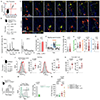Interruption of the intratumor CD8+ T cell:Treg crosstalk improves the efficacy of PD-1 immunotherapy
- PMID: 38861924
- PMCID: PMC11285091
- DOI: 10.1016/j.ccell.2024.05.013
Interruption of the intratumor CD8+ T cell:Treg crosstalk improves the efficacy of PD-1 immunotherapy
Abstract
PD-1 blockade unleashes potent antitumor activity in CD8+ T cells but can also promote immunosuppressive T regulatory (Treg) cells, which may worsen the response to immunotherapy. Tumor-Treg inhibition is a promising strategy to improve the efficacy of checkpoint blockade immunotherapy; however, our understanding of the mechanisms supporting tumor-Tregs during PD-1 immunotherapy is incomplete. Here, we show that PD-1 blockade increases tumor-Tregs in mouse models of melanoma and metastatic melanoma patients. Mechanistically, Treg accumulation is not caused by Treg-intrinsic inhibition of PD-1 signaling but depends on an indirect effect of activated CD8+ T cells. CD8+ T cells produce IL-2 and colocalize with Tregs in mouse and human melanomas. IL-2 upregulates the anti-apoptotic protein ICOS on tumor-Tregs, promoting their accumulation. Inhibition of ICOS signaling before PD-1 immunotherapy improves control over immunogenic melanoma. Thus, interrupting the intratumor CD8+ T cell:Treg crosstalk represents a strategy to enhance the therapeutic efficacy of PD-1 immunotherapy.
Keywords: CD8(+) T cells; F-IVM; ICOS; IL-2; PD-1; T regulatory cells; Treg; functional intravital microscopy; melanoma; tumor tolerance.
Copyright © 2024 Elsevier Inc. All rights reserved.
Conflict of interest statement
Declaration of interests T.R.M. is a founder and shareholder in Monopteros Therapeutics, Inc. This commercial relationship is unrelated to this study.
Figures







Update of
-
Interruption of the Intratumor CD8:Treg Crosstalk Improves the Efficacy of PD-1 Immunotherapy.bioRxiv [Preprint]. 2023 May 18:2023.05.15.540889. doi: 10.1101/2023.05.15.540889. bioRxiv. 2023. Update in: Cancer Cell. 2024 Jun 10;42(6):1051-1066.e7. doi: 10.1016/j.ccell.2024.05.013. PMID: 37292782 Free PMC article. Updated. Preprint.
References
-
- Motzer RJ, Tannir NM, McDermott DF, Arén Frontera O, Melichar B, Choueiri TK, Plimack ER, Barthélémy P, Porta C, George S, et al. (2018). Nivolumab plus Ipilimumab versus Sunitinib in advanced renal-cell carcinoma. New England Journal of Medicine 378, 1277–1290. 10.1056/NEJMoa1712126. - DOI - PMC - PubMed
MeSH terms
Substances
Grants and funding
- R01 AI168063/AI/NIAID NIH HHS/United States
- R01 CA278212/CA/NCI NIH HHS/United States
- F31 AR083279/AR/NIAMS NIH HHS/United States
- R01 AI123349/AI/NIAID NIH HHS/United States
- U01 AI160397/AI/NIAID NIH HHS/United States
- T32 AR080622/AR/NIAMS NIH HHS/United States
- P01 CA240239/CA/NCI NIH HHS/United States
- P30 CA062203/CA/NCI NIH HHS/United States
- R01 AI163223/AI/NIAID NIH HHS/United States
- R01 NS120060/NS/NINDS NIH HHS/United States
- P30 AR075047/AR/NIAMS NIH HHS/United States
- T32 AI177324/AI/NIAID NIH HHS/United States
LinkOut - more resources
Full Text Sources
Medical
Molecular Biology Databases
Research Materials

